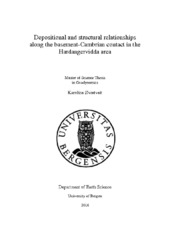| dc.description.abstract | The Scandinavian sub-Cambrian peneplain is an important reference surface used in reconstructing the geological evolution from the Neoproterozoic to the present. A detailed study of the geomorphological and structural features of the peneplain, in addition to lithological and stratigraphic relations, is restricted for the Hardangervidda area. The current study area document a geological evolution including Neoproterozoic rifting from the breakup of Gondwana, followed by the Cambrian transgression, in addition to the events of Caledonian thrusting and post- Caledonian extension. On the basis of extensive fieldwork, thin-section analyses and Scanning Electron Microscope (SEM) analyses, in addition to contouring the sub-Cambrian peneplain, the geology of the Hardangervidda area has been examined. The lithological units represented in this area include unweathered and weathered Precambrian basement, basal conglomerate and meta-sediments, quartz schists, phyllites and gneisses of the Caledonian thrust sheet. Microfabrics are mainly found in the weathered basement and the basal meta-sediments, and thin-section analyses of the phyllite unit display well-developed shear structures representing top-to-the-NW transport. Structural data of S-C structures, folds, and lineations recorded in the phyllite unit represent a prominent NW transport direction. Contour map and corresponding vertical profiles of the sub-Cambrian peneplain indicates irregularities with depressions up to 250 meters depth. Microstructures found in the weathered basement are proposed to have been formed during Caledonian and Devonian tectonic events. Poorly sorted basal conglomerate is suggested to have been deposited in a terrigenous environment by rivers or debris flow, possibly generated by Neoproterozoic faults. Local depressions of ca. 2 meter depths are likely to represent primary irregularities of the sub-Cambrian peneplain, whereas depressions up to ca. 250 meters are suggested to be representing later tectonic events and glaciations. The metamorphic grade at Hardangervidda decreases to the east, and is proposed to represent the east-southeast tapering of Scandinavia. The structures indicating top-to- the-NW transport are likely to be related to the extensional collapse of the Caledonian wedge. In overall, the geological evolution of the study area includes Neoproterozoic rifting, followed by Caledonian thrusting, exhumation and post-orogenic extension, which thus might represent the Wilson Cycle. | en_US |
